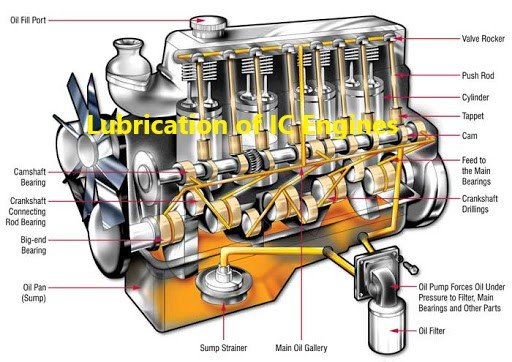
What is the Lubrication of IC Engines?
Lubrication is the process or technique employed to reduce the wear of one or both surfaces nearby and moving relative to each other. Interposing a substance called lubricant between the surfaces to carry or help carry the load (pressure generated) between the opposing surfaces. The moving parts of IC engines are required to be lubricated for proper functioning.
Purpose of Lubrication System
Lubrication of the moving parts of an internal combustion engine performs the following functions:
- Reduces wear and prevents the seizure of rubbing surfaces.
- Reduces the power needed to overcome frictional resistance.
- Removes the heat from the piston and cylinder.
- Serves as a seal between piston rings and the cylinder wall.
- Removes the foreign material from between the engine working parts.
What is Lubricant?
A lubricant is a substance introduced between two moving surfaces to reduce the friction and wear between them. A lubricant provides a protective film that allows two touching surfaces to be separated and “smoothed,” thus lessening the friction between them. Lubricants chemically interact with all surfaces so that contact only occurs with smooth and free lubricants. Abrasive particles are dissolved into the lubricant by this process, making them also excellent solvents and cleaners.
Engine Parts Requiring Lubrication
The main parts of an engine which require lubrication are:
- Main crankshaft bearing.
- Big end bearing
- Gudgeon pin bearing
- Piston rings and cylinder walls
- Timing gears
- Camshaft and Camshaft bearings
- Valve mechanisms
- Other moving parts such as cooling fan, water pump, ignition mechanism, and so on.
Lubrication Systems
The various systems adopted for the lubrication of an engine are –
- Petrol system
- Splash system
- Force feed system
1. Petrol system
This is generally used for small two-stroke engines, e.g., scooter and motorcycle engines. It is the simplest of all types of engine lubrication systems. A certain amount of lubricating oil is mixed with petrol its self, the usual ratio is 2% to 3% of fuel. If it is less, there is a danger of insufficient lubrication causing the image to the engine. If it is more, there will be excessive carbon deposits in the cylinder head, and the engine will also give dark smoke.
2. Splash system
A dipper is provided at the bottom end of the connecting rod scoops oil out of the pan placed below the crankshaft in this system. This pan receives its oil supply from the crankcase, either using a pump or by gravity through equalizer holes drilled in the pan. When the engine runs, the connecting rod scoops up oil as it passes over the bottom dead center. Part of the oil splashed by this connecting rod reaches the oil cups provided over the main bearings, and some of it enters the connecting rod bearing.
An oil mist created in the crankcase housing lubricates the piston, cylinder wall, and piston pin. If the camshaft is not located within reach of the splash, it is lubricated manually using the oil can. The engine valve mechanism is also lubricated by oil can at regular intervals.
3. Force-feed system
In this system, an oil pump takes the oil from the oil sump through a strainer and delivers it through a filter to the main oil gallery at a pressure of 2-4 Kg/cm“. From the main gallery, the oil goes through the drilled passages to the main bearings. The big-end bearing receives oil from the main bearings, and the small-end bearing and piston receive oil from the big-end bearing.
Piston and cylinder walls receive oil from the piston pin through drilled holes and oil rings in the piston. After lubricating the piston pin and cylinder wall, the oil drains back into the oil pan and is re-circulated through the lubrication system. A small pipe leads oil from the pump to the rocker-arm shaft. A valve stem is lubricated by oil coming out from the drilled rocker-arm shaft.
